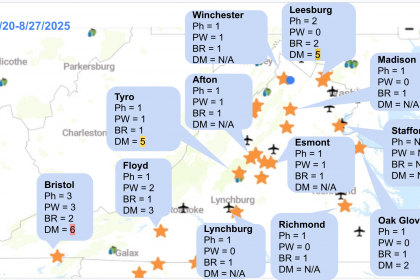Here’s a snapshot from the last week, showing the number of days with the risk of each disease: Ph = Phomopsis, PW = Powdery mildew, BR = Black rot, and DM = Downy mildew. At this point, you can ignore Phomopsis and black rot since Phomopsis should be done with their spore production, and clusters are resistant to black rot infection. This information was made available through the Wine Board-funded Sentinel Vineyard project.
It looks like we had another relatively dry week. The high number of days with downy mildew with low numbers of black rot risk (note: black rot is not an issue at this time of the year) most likely indicates a combination of warm and humid nights and occasional short rains. Please remind yourself that the best approach is prevention. Once we get behind and start playing catch-up, keeping healthy tissues remaining uninfected won’t be easy.
Please ensure you won’t violate the 66-day PHI of Mancozeb products. Some products have a relatively long PHI (e.g., Ranman’s PHI is 30 days). This post contains the list of fungicides with short PHIs. Make sure to read the label or refer to our PMG. Also, you may need to protect your vines against powdery mildew because they can infect leaves and shoots. Here’s a slide set from our previous meeting discussing late-season rot management.

The image above concisely summarizes the past seven days, aiding your understanding of recent events. However, the best action is proactively safeguarding your vines. For more comprehensive information, please visit https://newa.cornell.edu/, where you can access detailed daily weather data and disease and insect pest model results, including forecasted risks. We have covered the annual fee to ensure free access for growers in Virginia to the NEWA platform.
Utilizing this information, you can adjust your spray intervals accordingly. If you notice several days with disease risks, you may need to shorten your spray interval. Conversely, if you missed a material for downy mildew or black rot, you might consider using materials with kick-back activity. On the other hand, if the number of risks has been limited this year, you could extend your spray interval.
Remember that your spray decision should not solely rely on weather conditions. It is crucial to consider factors such as the cultivar and the disease history in your vineyard.
Drought Stress
Northern VA has been dry this season. Due to the condition, some vines are showing symptoms (wilting, and even dropping leaves and tendrils). Here is a nice article from the U. of Missouri. You may find some vines are affected more than others. This may be due to a number of factors such as abiotic or biotic damage to the trunk (the vascular system) and roots, soil types, topology, etc. I.e., you may or may not see uniform distribution of the symptoms. Also, due to relatively warm winters in the past several years, Pierce’s Disease has been frequently observed, especially in the vineyards located in the southern part of the state. Unfortunately, symptoms of Pierce’s Disease, especially on leaves, are somewhat similar to that of water stress, especially when the stress leads to nutrient deficiency.
| Pierce’s Disease | Water stress |
| Abscission of leaves | |
| Leaves break off at the junction of the petiole and blade and petioles remain green. (“Matchsticks symptoms”) | Leaves typically do not drop, until they become completely yellow and necrotic. |
| Leaf symptoms | |
| Chlorosis forms in bands and is bordered by necrosis or scorch. Veins remain green. Leaf senescence may start in the middle of a shoot. | The pattern of leaf chlorosis (yellowing) was more uniform. Veins become brown in color. Leaf senescence starts at the base. |
 |  |
Bernardo, S., Dinis, LT., Machado, N. et al. Grapevine abiotic stress assessment and search for sustainable adaptation strategies in Mediterranean-like climates. A review. Agron. Sustain. Dev. 38, 66 (2018). https://doi.org/10.1007/s13593-018-0544-0
In general, symptom development of Pierce’s Disease is relatively slow compared with drought stress, which can happen quickly. If you are in doubt, Virginia Tech’s Plant Disease Clinic can run a test for Pierce’s Disease. Please contact your local Extension agent for sample submission.





